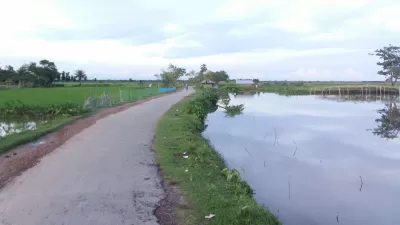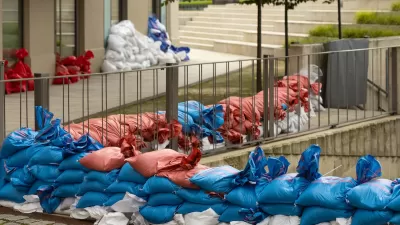Simple, sometimes ancient designs can transform roadways into environmental conservation tools.

In an article from Yale Environment 360 republished in Wired, Ben Goldfarb, author of Crossings (one of Planetizen’s Top Planning Books of 2023), describes how new methods for greening roadways can help turn impermeable roads into environmental assets.
Goldfarb outlines a program titled Green Roads for Water built on the concept of using roads “to direct and collect water in desirable locations, rather than undesirable ones.” As the article explains, “The techniques tend to be astonishingly simple. Gentle earthen ridges called crossbars guide water off roads and toward irrigation ditches. ‘Borrow pits’ left after the excavation of gravel can be repurposed as rainwater collection ponds. In Bangladesh, engineers have deployed gated culverts to channel floodwaters into rice paddies.”
The program has spread rapidly in developing countries alongside “a wave of construction that could produce more than 15 million miles of paved roads by mid-century and tens of millions of miles of unpaved roads.” Using Green Roads strategies can help mitigate the negative impacts of new roads and prevent them from disrupting local ecosystems.
FULL STORY: This Radical Plan to Make Roads Greener Actually Works

Study: Maui’s Plan to Convert Vacation Rentals to Long-Term Housing Could Cause Nearly $1 Billion Economic Loss
The plan would reduce visitor accommodation by 25,% resulting in 1,900 jobs lost.

North Texas Transit Leaders Tout Benefits of TOD for Growing Region
At a summit focused on transit-oriented development, policymakers discussed how North Texas’ expanded light rail system can serve as a tool for economic growth.

Using Old Oil and Gas Wells for Green Energy Storage
Penn State researchers have found that repurposing abandoned oil and gas wells for geothermal-assisted compressed-air energy storage can boost efficiency, reduce environmental risks, and support clean energy and job transitions.

Private Donations Propel Early Restoration of Palisades Playground
Los Angeles has secured over $1.3 million in private funding to restore the Pacific Palisades playground months ahead of schedule, creating a modern, accessible space that supports community healing after recent wildfires.

From Blight to Benefit: Early Results From California’s Equitable Cleanup Program
The Equitable Community Revitalization Grant (ECRG) program is reshaping brownfield redevelopment by prioritizing projects in low-income and environmental justice communities, emphasizing equity, transparency, and community benefits.

Planting Relief: Tackling Las Vegas Heat One Tree at a Time
Nevada Plants, a Las Vegas-based nonprofit, is combating the city’s extreme urban heat by giving away trees to residents in underserved neighborhoods, promoting shade, sustainability, and community health.
Urban Design for Planners 1: Software Tools
This six-course series explores essential urban design concepts using open source software and equips planners with the tools they need to participate fully in the urban design process.
Planning for Universal Design
Learn the tools for implementing Universal Design in planning regulations.
Ascent Environmental
Borough of Carlisle
Institute for Housing and Urban Development Studies (IHS)
City of Grandview
Harvard GSD Executive Education
Toledo-Lucas County Plan Commissions
Salt Lake City
NYU Wagner Graduate School of Public Service





























